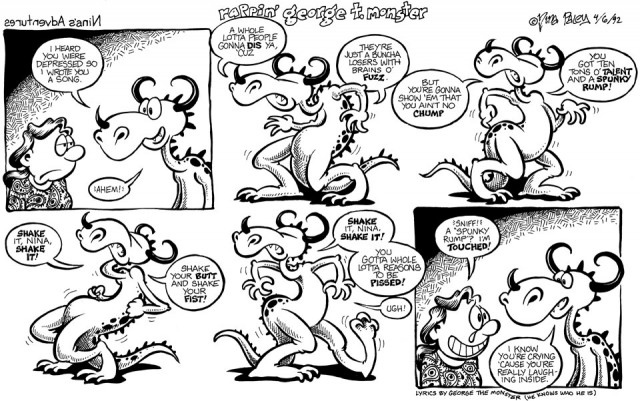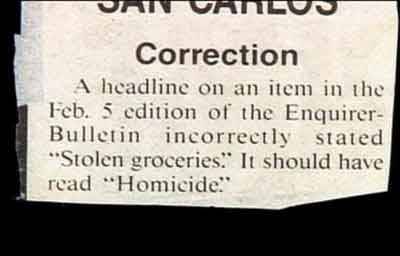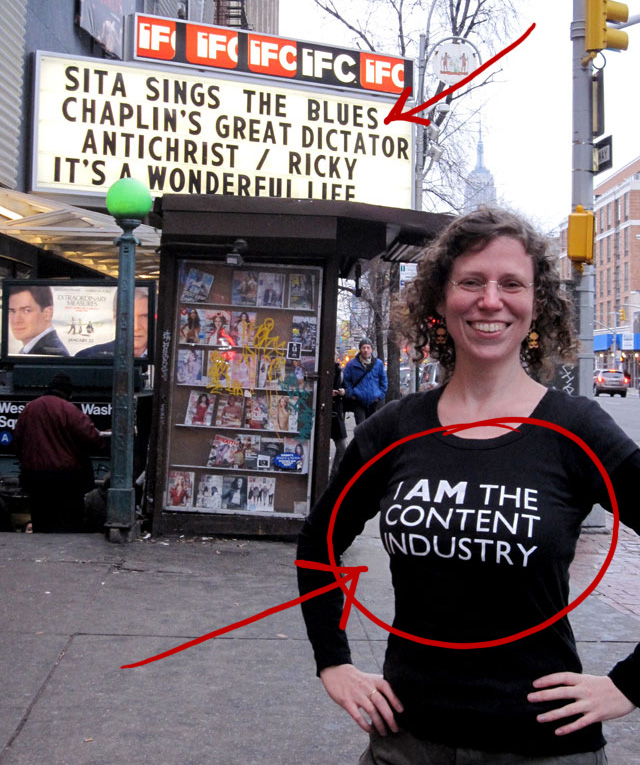Animated, directed, written, produced, etc. by Nina Paley
Starring Mimi (of Mimi & Eunice)
Sound Design by Greg Sextro
Produced with assistance from QuestionCopyright.org
Category: Free Culture
Mimi & Eunice return!
 Check out this comic and more on mimiandeunice.com!
Check out this comic and more on mimiandeunice.com!
And they’re embeddable now! Thanks to Mike Caprio for rebuilding the site from scratch. Looking for a specific strip? See thumbnails of the complete archives all at once, or larger strips on the feed page. All comics at mimiandeunice.com link to gigantic high-res PNGs which you can reprint and publish without permission! CopyLEFT, baby.
My Official Fight Song
 I’ve been digging through my old original comics archives, selecting artwork for upcoming exhibits at the San Francisco Cartoon Art Museum and the Betty Boop Festival in Wisconsin Rapids, Wisconsin. This old gem, while not one of my best, has extra sentimental value. “George the Monster,” who featured in early Nina’s Adventures strips, is my longtime friend Ian Akin. Remarkably, we’ve stayed friends almost 22 years. In fact Ian is visiting me in New York right now! I’d forgotten all about this song he wrote for me when I was fighting some battle or other in my 20’s. Upon rediscovering it, I found it’s just as cheering as I fight some battle or other in my 40’s.
I’ve been digging through my old original comics archives, selecting artwork for upcoming exhibits at the San Francisco Cartoon Art Museum and the Betty Boop Festival in Wisconsin Rapids, Wisconsin. This old gem, while not one of my best, has extra sentimental value. “George the Monster,” who featured in early Nina’s Adventures strips, is my longtime friend Ian Akin. Remarkably, we’ve stayed friends almost 22 years. In fact Ian is visiting me in New York right now! I’d forgotten all about this song he wrote for me when I was fighting some battle or other in my 20’s. Upon rediscovering it, I found it’s just as cheering as I fight some battle or other in my 40’s.
Although the comic says ©, it’s now copyLeft like all my old comics. CC-BY-SA.
Correction, again
I’m reposting this (originally posted July 2009) because misinformation continues to spread all over the interwebs. Maybe I’ll post it every month.
Dear Journalists Dear Journalists, bloggers, commenters, etc.,
Some of you are writing that I was forced to choose the Creative Commons Attribution Share Alike license because the film is violating copyright. That is completely untrue, but has become the dominant motif of stories I read about the project. The confusion is understandable, so I attempt to sort it out below.
Sita Sings the Blues is 100% legal. I am free to release it commercially, which is why the film is gaining a number of commercial distributors in addition to its free sharing/audience distribution, which is also legal, and wonderful.
Sita Sings the Blues is in complete compliance with copyright regulations. I was forced to pay $50,000 in license fees and another $20,000 in legal costs to make it so. That is why I am in debt. My compliance with copyright law is by no means an endorsement of it. Being $70,000 in the hole reminds me daily what an ass the law is. The film is legal, and that legality gives me a higher moral ground to stamp my feet upon as I denounce the failure that is copyright.
Having paid these extortionate fees, I could have gone with conventional distribution, and was invited to. I chose to free the film because I could see that would be most beneficial to me, my film, and culture at large. A CC-SA license does not absolve a creator of compliance with copyright law. The law could have sent me to prison for non-commercial copyright infringement. I was forced to borrow $70,000 to decriminalize my film, regardless of how I chose to release it.
Note that in some ways the film is not, and never will be free. For each disc sold, distributors must pay $1.65 to these faceless money sinks. Transaction costs raise that amount to about $2.00 per disc. That is why my own Artist’s Edition is limited to 4,999 copies. I’ve already bled $50,000 into their vampiric maws; I have no intention of paying more.
Thank you for your attention.
Love,
–Nina
What’s wrong with “streaming” DRM?
Judging from comments here, at Techdirt, and at BoingBoing, there seems to be much confusion about why I don’t want DRM on Sita Sings the Blues. The simplest explanation is this: I am making my film available to all under an open license. Allowing a party to take the benefit of that license, but then limit the rights of downstream users is inconsistent and frustrates the original purpose of the open license — to promote and facilitate access and use of the work.
Some people seem to think DRM is irrelevant on “streaming content.” I was one of them, which is why I was initially so indecisive about the Netflix streaming offer. DRM encourages people to think of certain liberties as being impossible, rather than merely taken away. Already many people think that “streaming” means “cannot be saved on my computer,” instead of “optimized for real-time flow”. People make this false equation entirely because of user-side DRM.
So along with its other problems, DRM is a kind of anti-literacy device for the digital age. The more hobbled people’s phones and computers and music players get, the harder it is to remember what it was like when those devices served their users rather than the monopolists. The more deeply embedded DRM becomes, the more its restrictions will come to feel like “just the way things are”, rather than an impediment that could conceivably be removed or worked around.
I respectfully submit a typical comment:
Its not a download or purchase , its “Free Streaming” . From my Roku box to my tv why should you or I care if it has drm.
This is a perfect example of the kind of illiteracy mentioned above. “…we’re talking about a stream, which by definition is not saved on your computer”. This commenter and others have bought the industry’s definition of “stream”, even though there’s nothing inherent in streaming that prevents saving. I can’t blame them; until last week, I didn’t think about what “streaming” meant either.
Here’s another typical comment:
You’re obviously making a symbolic stand here. That’s fine. But please at least be honest about that instead of claiming that Netflix streaming is “breaking” my home electronics. My computer and my Xbox work just fine and my rights have not been violated in any tangible or meaningful way.
If data is sent to your computer, and yet your computer won’t let you save that data, than an important function of your computer has been interfered with. Who does your computer work for, anyway, you or them? It’s not just a hypothetical breakage, either. For example, if you wanted to divide the same incoming stream to two different computers in your house, similarly to how a “Y” pipe would do with water, Netflix DRM will prevent that. Normally, your computer could do that just fine, but not when it’s broken.
If the quibble is with the word “broken,” we can use the less-inflammatory word “disabled,” although people are eager to forget that “disabling” a computer means “breaking it in increments.”
♦♦♦♦♦♦♦♦♦♦♦
My rejection of DRM is not a condemnation of Netflix (I like Netflix!) nor of those who use this very convenient service. I made this difficult decision as the author of Sita Sings the Blues. The only reason Netflix has DRM on its streams is because of pressure from the “content industry.” Well guess what – I am the content industry too, and I say no to DRM.
Thanks to Karl Fogel for contributing to this article.
Turning down Netflix
Sita Sing the Blues has a few Endorsed DVD distributors. In addition to QuestionCopyright.org and myself, there’s FilmKaravan, a distribution collective that handles “downstream” deals with VistaIndia and IndiePix. Their distributions are on amazon.com (I get a much smaller percentage from those than from my DVDs, but they reach a much wider market) and Netflix.
In addition to physical DVD rentals, Netflix offers subscribers instant electronic delivery: streaming movies over the Internet to Mac, PC, Wii, PS3 and Xbox players. Many subscribers conveniently find new titles through this service. It’s just the sort of distribution channel that benefits a small film like Sita. They also pay producers, and don’t demand exclusivity. It’s a good deal all around, except for one problem: DRM.
DRM, or Digital Restrictions Management, is technology “to control use of digital media by preventing access, copying or conversion to other formats by end users.” At best DRM reduces the functionality of computers; at worst it invades privacy and adds surveillance and malware. DRM End User License Agreements (EULAs) force users to surrender rights well beyond what copyright restricts.
In the last few years DRM has grown increasingly pervasive, with little-to-no press coverage. Consumers passively accept it, as proven by Apple’s new “everything-DRM” device, the iPad.
Creators, too, are accepting DRM as a fact of media distribution; offered no alternatives, they lose their ability to even imagine alternatives. DRM, like rights monopolies, is said to be made for creators. But like copyright, DRM is designed to benefit Big Media conglomerates, not artists.
If this type of invasion of privacy were coming from any other source, it would not be tolerated. That it is the media and technology companies leading the way, does not make it benign. (link)
A few weeks ago a content aggregator called Victory Multimedia contacted FilmKaravan:
Netflix has shown interest in carrying your title “Sita Sings the Blues” for Electronic Delivery. For a 12 month license period they are offering $4,620.00. You would received $2310.00 no later than 60 days after the Netflix title release date and the balance of $2310.00 will be paid 6 months after the initial payment.
First I asked (Filmkaravan to ask the aggregator to ask Netflix) if Netflix could make a DRM exception for Sita. Unfortunately no such option currently exists in Netflix’s electronic delivery system. Possibly no other filmmakers have even asked for such an option. iTunes used to offer only DRM music, but eventually enough people – including savvy “content providers”? – demanded DRM-free channels that they now offer DRM-free music for sale along with Defective options (all iTunes movies carry DRM). Filmmakers lag far beyond musicians in understanding the Internet, so it may be a while before Netflix, Amazon, iTunes, and other online distributors allow our “content” in their channels without adding malware and spyware to our films.
I still wanted Sita to be in Netflix’s on-demand system. I want as many people to see Sita as possible; surely many viewers now rely on such a convenient delivery system to explore new films. Anyone who became a fan of Sita this way might still find the film’s web site, and learn how to download a free copy for themselves. Although Sita’s site states:
You are not free to copy-restrict (“copyright”) or attach Digital Restrictions Management (DRM) to Sita Sings the Blues or its derivative works.
I could still grant special permission to Netflix to add DRM to Sita. I asked if I could add a card to the front of the movie stating simply:
Download and share this film from:
sitasingstheblues.com
The aggregator responded this was not possible, due to a Netflix “no bumpers” policy.
Looking back, I was conflicted because it was hard for me to see the DRM on Netflix’s streaming service as problematic. It’s not as though Netflix is telling anyone they’re “buying” the movies they stream; they’re just “renting” them. “Rental” already implies restrictions and limited use terms. They’re just trying to make the Internet work like the physical world, imposing artificial scarcities to resemble the natural scarcities of physical DVD rentals. We can accept natural scarcities; why not accept artificial ones?
I was so conflicted, I asked my “Facebook friends” for advice. Responses were pretty split. Only a few knew what DRM was, but understood I could be compromising my principles by endorsing its use. Was that compromise significant? Was it time to “rise above my principles”?
Facebook, being a walled garden whose “business model is spying,” is problematic itself; obviously I use it anyway, although I don’t expect it to be around in a few years unless it opens up. Two of my moral guidestars don’t use it out of principle, and I emailed them for advice. Richard Stallman wrote,
I faced the same sort of question today: whether to approve release of my biuography with DRM for the iBad. I said no, because the fight against DRM is my cause, and the iBad is the most extreme attack against computer users’ freedom today.
It is self-defeating to try to promote a cause by supporting a direct attack against it. Lesser forms of participation in things that you hope to eliminate can be overlooked, but Netflix is something we must specifically fight. The example you would set by giving in would undermine everything….
We launched an action against Netflix. We tell people, “Don’t be customers of Netflix.”
So I learned Netflix DRM was “real” DRM, rental or not. DefectiveByDesign.org asks people who rent physical DVDs from Netflix, to protest their DRM-laden electronic delivery service.
It was John Gilmore’s email that hit me where I live:
Don’t post your film via a DRM service.
Insist that Netflix is free to release it without DRM, but they cannot release it with DRM.
Creators keep knuckling under to these media middlemen who push DRM onto end users for their own lock-in reasons. Like Apple. Like CDbaby.
It will take pushback from creators to change this. Be the change that you want to see….
I’ve been the “change I want to see” in regards to copyright monopolies. People told me I’d lose everything by copylefting Sita, including all hope of professional distribution. But in fact, some professional distributors became willing to distribute Sita without claiming monopolies over it, and we’re all fine.
I’d still love Sita to be offered through Netflix’s online channels; if they ever offer DRM-free video-on-demand, I hope they remember Sita Sings the Blues.
For now, people will just have to obtain Sita by visiting the vast big Internet outside of Netflix. Most of the Internet still isn’t enclosed by Netflix, or Amazon, or iTunes. Most of the Internet is still Free; I’m doing what little I can to keep it that way. I’m sad to lose the potential viewers who may have found Sita through Netflix’s electronic delivery. But maybe some of those Netflix subscribers will discover the rest of the Internet because of my tiny act of resisting DRM.


